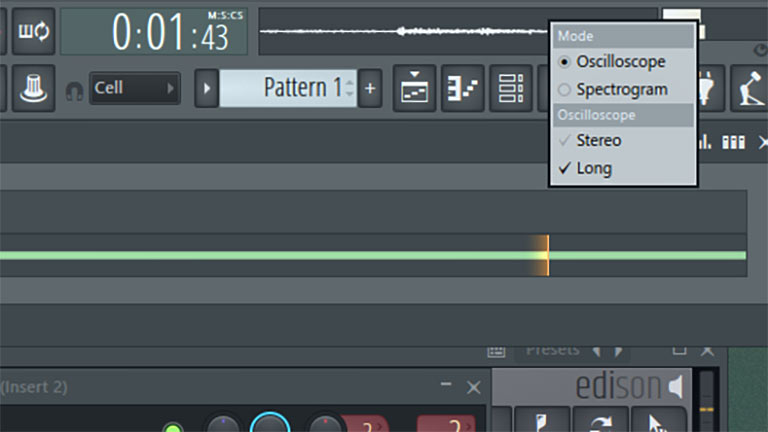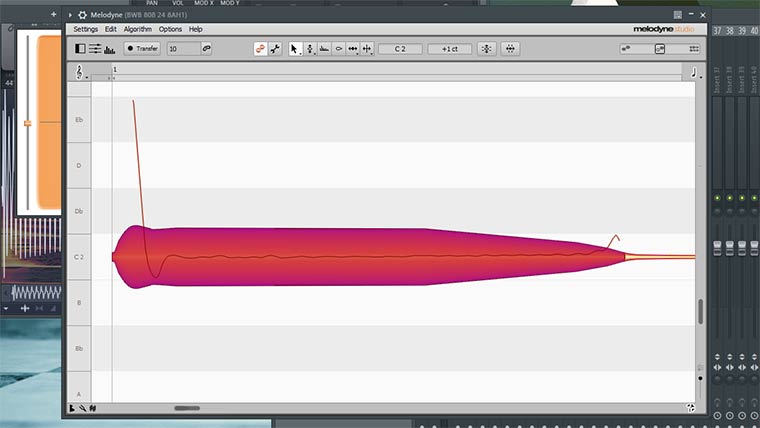Are you struggling to tune your 808s?
Then you need this quick tip!
Most producers use edison to find the key of an 808, by going to Edison> Regions> Detect Pitch Regions. This method is slow and doesn’t provide the detune amounts to get it perfectly in key. I have a better method with no guesswork.
The guys at image-line makers of FL Studio made the perfect tool for this job right in front of your eyes! No dirty plugins, no messing around with tuning by ear, completely uber noob friendly. If you want to learn the secrets young apprentice, stick around.
Here’s how to be a 808 tuning ninja!
Step 1: The Setup
Ensure you have the ‘Oscilloscope Analyzer’ option selected in your FL toolbar. The ‘Stereo’ option should be deselected and ‘Long’ option should be selected. If you’re unsure or need to change these options, Right Click the analyzer.

To give a better view you can right click the toolbar to resize the analyzer, shown below. This is optional but give you more room to see a big fat 808ski. We say go big or go home.
Step 2: Load your 808
Drag your 808 into the Channel Rack as you would with any sample. Click on the wrench icon to get to Miscellaneous Settings and the root key / tuning controls. Don’t be a noob and use the pitch wheel!
Step 3: Tune to C
Amazingly, the analyzer window is tuned to a perfect ‘C’ on the keyboard. So we can use it now to tune anything we want, but it’s especially killer for 808s and basses.
Moving to the left then it’s sharp…
Waveform is static, you’ve hit a perfectly in tune C…
Moving to the right it’s flat…
If it moves really fast or is a mess, then you’re not playing C
You can play your 808 with the ‘qwerty’ keyboard using the ‘Q’ or ‘Z’ keys to play C, changing the root notes as shown in the following clip. You can fine tune this to perfection, all without breaking your workflow or opening any new windows!
Now your 808 has it’s root tuned to C, you can copy over bass notes from your midi and they will work seamlessly.
Tips and Tricks
If your waveform is really small you can play an octave lower to get a bigger waveform.
If your waveform is ghosted and you can see both ascending and descending waveforms play 1 octave up.
Some 808s have very strong harmonics that are a perfect 5th above the actual root note. Sometimes you can see these and tune to the wrong note via this method. If it still sounds out of key. Take the root note and move it either 7 semitones higher or 5 semitones lower. You should immediately hear it sound correct. The waveform will also look cleaner. If you accidentally tune to the harmonic instead of the route, you can see one and a half cycles of the note before it repeats.
Try tuning a folder of 808 basses, you can tell if you’ve mastered the technique when they match. It should take no more than a few seconds on each. If you’re feeling bold, you can render the 808s at C for later, you’ll have your very own collection of tuned 808s to further speed up your musical creativity.
Conclusion / Alternatives
I’ve not seen any tutorials use this technique or explain how to use it. So thought an explanation was in order. I’ve been using this method for years without the need for perfect pitch and it can be done muted too.
If you’re an Ableton Live, Cubase, Reaper users. Let me know the quickest way you tune your 808s. My personal favourite alternative is to use Celemony Melodyne Studio it’s slower IMO than the method in FL Studio and is a pricey alternative but gives you a view of exactly where the pitch settles. You can see below that it’s C2 +1ct.

Good luck, you’re now an 808 bass ninja. No more excuses for flabby out of tune basses over that next beat!

Comments 1
thank you